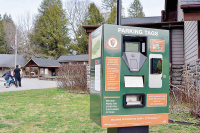A witness to the Cherokee renaissance
The Eastern Band of Cherokee Indians has a resilient, independent spirit. When the U.S. government forced the majority of the tribe to head west to Oklahoma on the Trail of Tears, those who remained were the defiant ones, and it is their offspring who now form the nucleus of the tribe. It is these Native Americans who are using the profits from what was originally a controversial casino to help rediscover their cultural identity.
Prior the construction of Harrah’s Cherokee Casino, the Eastern Band were a poor tribe with little influence. Tribal members who lived in Cherokee struggled to make a living in a tourism-dominated economy. Because there was little industry and because the region was so isolated, the area around Cherokee, Swain and Graham counties perennially topped the state in unemployment, averaging around 25 percent for many years when the state first started keeping statistics.
Much of that changed with the coming of casino profits. The tribe found itself with a newfound wealth and power. What’s noteworthy in this transformation is how that money has been used to invest in Cherokee and its people, when it could have gone to line the pockets of only the most powerful.
The Cherokee Preservation Foundation might be the most notable symbol of this transformation. The Foundation was created as part of the second gaming compact with the state in 2000, and it has funneled millions of dollars into cultural, historical and economic development projects on the Qualla Boundary and surrounding region. Those investments include the Cherokee language immersion program, a Native American art institute, helping restore rivercane for traditional basketmaking, investing in traditional Cherokee arts such as metalsmiths, making broadband more available in rural Western North Carolina and dozens of other worthwhile projects.
The tribe itself has built a new school that uses green technology and celebrates tribal traditions, invested in health care and public safety, and is teaching its youth how to wisely manage the per capita payments they receive from casino profits. It also helps each of its high school graduates pay for college. Men and women who work for the tribe earn good wages and benefits.
In other words, the tribe is investing in itself, its people and its traditions. When you talk to members of the tribe today, the pride in what is happening in Cherokee is obvious.
Related Items
There are still problems in Cherokee, just as there are everywhere in this country. But over the past decade those of us who live here have witnessed a resurgence among the Eastern Band that surpasses what most thought possible when gambling was first approved. They’ve used the casino profits wisely, to say the least. That’s a credit to the Eastern Band members and its leadership.
(Scott McLeod can be reached at This email address is being protected from spambots. You need JavaScript enabled to view it..)









